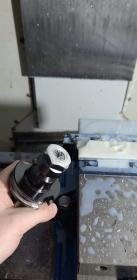nccknives
Plastic
- Joined
- Aug 19, 2013
- Location
- brooklyn ny
hey guys so I got a second mini mill 01 last month and its been making great parts up until yesterday when I crashed it by plunging it in rapids right into my part due to odd settings from the previous owner causing my offsets to be off by .48. unfortunately something in the head had shifted after. I rechecked my z offset and noticed that everything was .0195 higher then prior. I'm assuming that the linear bearing rails must have sliped from the crash but everything still ran fine including tool changes after I reset my tool offsets. the only thing off was the floor finish of the part. I then switched out the part for a 4x6 pallet to try faceing with a 3" facemill to find it leaving a horrible dished finish when moving in x and a huge step over when cutting in Y. From what I cant tell the head is now tilted to the left and not just by a few tenths but a decent amount. I wont know until Monday exactly how much the step was but id guess a couple thou so simply shimming the spindle doesn't seem like the fix here. I was told I may have to block the spindle then loosen the linear bearing bolts and possibly shift the whole head slightly before retightening them. I did plan on calling in a tech but figured id try something before calling in the tech. Any advice would be appreciated as the mill was perfectly square prior. I included a picture of the crash and the test face i did, you can visually and physically see the substantial step.








